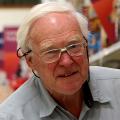We are always gazing skywards, but what about the worlds beneath our feet? Harry Mead digs in to Underland to find out what's there.
I CAN’T begin any better than by quoting the author: “We know so little of the worlds beneath our feet. Look up on a cloudless night and you might see the light from a star thousands of trillions of miles away… Look down and your sight stops at topsoil, tarmac, toe. I have rarely felt as far from the human realm as when only ten yards below it.”
Even so, Robert Macfarlane’s venture into this “underland,” as he terms it, to learn more of “the complex relationship with the world beneath our feet,” often took him far deeper than ten yards. But nowhere deeper than the half a mile to the foot of Boulby potash mine, Europe’s deepest mine, in the North York Moors. He descended to witness the search going on there for dark matter, the micro atoms science now confidently believes make up about a quarter of the total mass of our planet.
But their existence is unproved and Macfarlane calls the search for them a form of “ghost hunting”. He learns that deep underground is the best place to conduct it because it is free from background noise. Not human noise, which is easily shut out, but the planet’s own noise, deafening in this context, of cosmic rays and radiation. “If you wish to listen for sounds so faint they may not exist, you can’t have someone playing drums in your ear,” Macfarlane observes.
No particle has yet been detected. But what a picture Macfarlane paints of Boulby’s mining activity. He writes: “For the miners it is like labouring in the Sahara at noon, in darkness.” Toiling in a temperature of 45 degrees C, each man carries four litres of chilled water. A dramatic spectacle is of “a huge red and black machine, low-slung and sharp-toothed as a Komodo dragon, feeding at a rock face. The dragon is controlled via a thick black rubberised cable, as if on a dog leash.”
Focused on a feature called a Time Projection Chamber, the dark-matter research lab is, says Macfarlane, “a true Doctor Who place." He draws what at first seems an improbable analogy with Rievaulx Abbey, elsewhere in the Moors. The monks, he says, “built a space… in which prayers were offered to a presence disinclined to disclose itself to the usual beseechings.” Perceiving dark matter as another “invisible universal entity that refuses to reveal itself”, Macfarlane suggests the search for it “seems to resemble what we call religion rather than what we call science.”
A work of powerful imagination, Underland seeks to counter what Macfarlane sees as “a long cultural history of abhorrence around underground space.” “Dirt, mortality and brutal labour are the dominant connotations,” he writes. How different is arguably his most remarkable ‘underland’ - the amazing, recently discovered, life-sustaining network known as the ‘wood-wide web'. Still not fully understood, this underground fungal network links neighbouring trees. Through it, they can alert each other of disease or insect attack, enabling them to resist. After hearing details from an ecologist in Epping Forest, Macfarlane remarks: “I find it hard not to imagine these arboreal relations in terms of tenderness, generosity, even love… I am reminded how resistant the underland remains to our usual form of seeing… Just a few inches of soil is enough to keep startling secrets… an eighth of the world’s total biomass comprises bacteria below ground.”
A Cambridge University scholar noted for books on nature, place and people, Macfarlane went underground himself, not only into Boulby mine, but caves in the Mendips and Norway, the former a major prehistoric burial ground, the latter rich in ancient prehistoric art. The catacombs of Paris and a Finnish nuclear-waste ‘repository’ were other sites.
Macfarlane classes the world’s nuclear tombs as “the Cloaca Maxima – the Great Sewer of our species.” He asks: “What legacies will we leave behind, not only for the generations that succeed us but also for the epochs and species that will come after ours. Are we being good ancestors?”
Back at Boulby, he spotted a worn-out Komodo dragon abandoned in a tunnel recess. (It’s too expensive to remove them.) The soft deposit will gradually settle round it. Macfarlane wonders whether a future geologist will correctly identify the lizard-like fossil as a machine rather than a creature. Reflecting on the immense human damage to the planet, he believes we all need to learn to think ahead into “deep time” – though this “runs against the mind’s grain.”
He explains: “Try it for yourself, now. Imagine forwards a year. Now ten. Now a century. Imagination falters, details thin out. Try a thousand years. Mist descends. Beyond a hundred years even generating a basic scenario for individual life or society becomes difficult, let alone extending compassion across much greater reaches of time towards unborn inhabitants of worlds-to-be.”
Perhaps to get it right we need to feel the kind of bond aroused in Macfarlane by the sight of prehistoric hand-marks on cave walls. “I imagine laying my own palm precisely against the outline left by those unknown makers. I imagine, too, feeling a warm hand pressing through from within the cold rock, meeting mine fingertip to fingertip in an open-handed encounter across time.” More of it than you think related to the ‘underland.’
Underland by Robert Macfarlane (Hamish Hamilton, £20)






Comments: Our rules
We want our comments to be a lively and valuable part of our community - a place where readers can debate and engage with the most important local issues. The ability to comment on our stories is a privilege, not a right, however, and that privilege may be withdrawn if it is abused or misused.
Please report any comments that break our rules.
Read the rules here